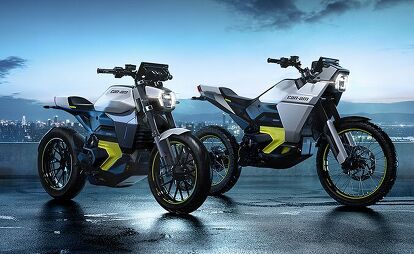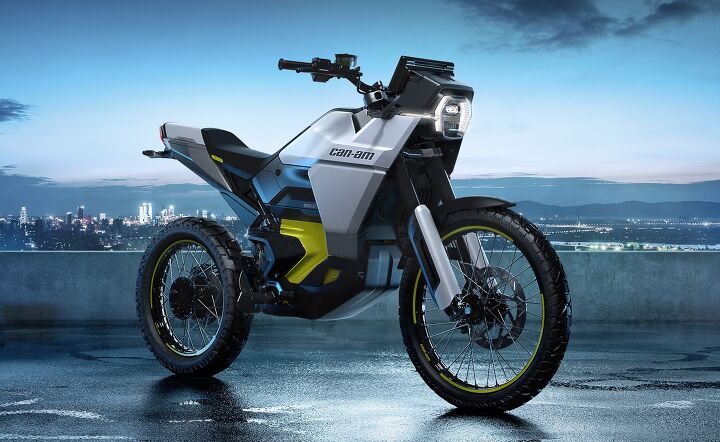2024 Can-Am Origin and Pulse Electric Prototypes – First Look

Full specs won't be revealed until next August
After teasing us in March, Bombardier Recreational Products officially revealed its first two Can-Am electric motorcycles, the Pulse roadster and the Origin dual-sport. Both models were presented as prototypes, meaning they are very close to what will eventually be the final product, which will enter production in the summer of 2024.
Full specs will be revealed next August, so the focus of this “soft reveal” is purely on the design of the first two-wheeled Can-Am models since 1987. Both models employ what BRP calls the Rotax E-Power powertrain. Specific numbers weren’t given, but BRP says it will yield “highway-worthy speeds with plenty of horsepower and torque.” The Rotax E-Power technology will eventually be employed across BRP product lines, not just motorcycles.
Like most electric motorcycles, the Pulse and Origin forgo a clutch or transmission, using just a simple twist-and-go throttle. Both models employ an on-board charger and work with Level 2 charging stations. BRP did not provide any information on the batteries, except to note that they are highlighted in the designs in Can-Am’s signature yellow.
Both models employ a single-sided swingarm with the final drive completely enclosed on the left side. Patent illustrations we previously uncovered suggest the swingarm houses a belt drive, though BRP notably refused to confirm when asked about it during its media presentation.
The Origin and Pulse will be just the first of a whole line of electric Can-Am motorcycles. The patents describe a modular system that allows BRP to attach different elements to the E-Power unit to suit different configurations.
“Today, our story of innovation reaches new heights,” says José Boisjoli, President and CEO of BRP. “We have set out to reclaim our motorcycle heritage and are very proud to re-enter the market with the introduction of the first two models of our all-electric Can-Am motorcycle family. Half a century ago, Can-Am roared to victory on the track and the trail, and today, a legacy is reborn. In true BRP fashion, we are bringing our very own electric powerpack to our motorcycles, and crafting thrilling riding experiences for a whole new generation.”
Can-Am Origin dual-sport
The Can-Am Origin has an upward rising fairing, giving it a Dakar-inspired profile similar to what you’d find on the Ducati DesertX or Husqvarna Norden 901. Like those bikes, the Origin is beakless, with a fender hugging the 21-inch front tire.
The fairing shrouds the distinctive headline design that will be shared across all Can-Am motorcycles. The headlight employs two LEDs aligned like an equals sign surrounded by outer LEDs that extend outward along the sides of the light. It’s an interesting design, but we wonder if it will comply with regulations, as the headlight would be quite visible from the side of the motorcycle, and comes really close to the turn signal stalks.
The frame is well hidden behind the bodywork, with the battery pack appearing to be a stressed part of the chassis. The subframe is bolted onto the back of the battery, reflecting the modular design BRP is using for its electric motorcycles.
The suspension system is comprised of an inverted fork and a rear monoshock. We don’t see any evidence of adjustability, but that may change on the final production version. Up front, the Origin uses a single brake with an axial mount caliper. ABS should be expected, and the front wheel does appear to have a sensor ring.
The badging on the Origin is surprisingly understated. Beyond the “Can-Am” logo on the side fairing, there’s a small “Rotax E-Power” label on the sides, right above the yellow battery pack, and a small yellow “Origin” badge on the side of the seat. The tail cover has a small indent on the sides with a small label reading “Can-Am Motorcycles Est. 1973”, a nod to the brand’s history.
Can-Am Pulse roadster
The Pulse shares a lot of elements with the Origin, but in a Standard motorcycle configuration. Instead of the Origin’s wire-spoke wheels, the Pulse uses cast wheels and shorter supsension, while the tail is flatter, offering a lower seat height.
The footpegs on the Pulse are lower than on the Origin, while the handlebars are lower and positioned farther forward, providing completely different ergonomics.
The headlight unit is similar, but angled slightly back and not covered by a fairing. The “fuel tank” is longer and flatter than on the Origin, with sculpted sides giving it a much different look than the dual-sport’s flatter bodywork.
Without the Origin’s fairing, the digital display appears much more exposed on the Pulse, and we wonder if the large screen could benefit from some additional protection.
Of course, the most important questions remain to be answered. There’s no indication of how much power either the Origin or Pulse will produce, though the single disc brake would suggest the maximum output will be modest. We also don’t know the battery capacity, range, or weight for either model. Those details will have to wait for at least another year, while pricing won’t be revealed until closer to their 2024 launch target.
Become a Motorcycle.com insider. Get the latest motorcycle news first by subscribing to our newsletter here.

Dennis has been a part of the Motorcycle.com team since 2008, and through his tenure, has developed a firm grasp of industry trends, and a solid sense of what's to come. A bloodhound when it comes to tracking information on new motorcycles, if there's a new model on the horizon, you'll probably hear about it from him first.
More by Dennis Chung







































Comments
Join the conversation
I love a single-sided swingarm. The Pulse roadster could have been a modern take on the 916 if they'd routed the exhaust under the seat.
super cruiser can - am electric motorcycle